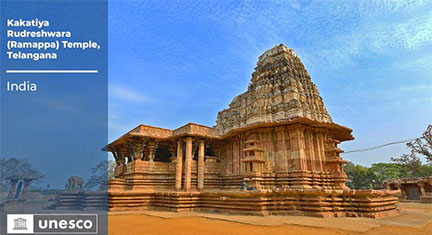Important Facts For Prelims
India’s 39th World Heritage Site: Ramappa Temple
- 26 Jul 2021
- 3 min read
Why in News
Recently, Rudreswara Temple, (also known as the Ramappa Temple) at Mulugu district, Telangana has been inscribed on UNESCO's World Heritage list.
- Ramappa Temple was proposed by the government as its only nomination for the UNESCO World Heritage site tag for the year 2019.
Key Points
- About Rudreswara (Ramappa) Temple:
- The Rudreswara temple was constructed in 1213 AD during the reign of the Kakatiya Empire by Recherla Rudra, a general of Kakatiya king Ganapati Deva.
- The presiding deity here is Ramalingeswara Swamy.
- It is also known as the Ramappa temple, after the sculptor who executed the work in the temple for 40 years.
- The temple stands on a 6 feet high star-shaped platform with walls, pillars and ceilings adorned with intricate carvings that attest to the unique skill of the Kakatiya sculptors.
- The foundation is built with the “sandbox technique”, the flooring is granite and the pillars are basalt.
- The lower part of the temple is red sandstone while the white gopuram is built with light bricks that reportedly float on water.
- An inscription dates the temple to 1135 Samvat-Saka on the eight-day of Magha (12th January, 1214).
- The distinct style of Kakatiyas for the gateways to temple complexes, unique only to this region, confirm the highly evolved proportions of aesthetics in temple and town gateways in South India.
- European merchants and travellers were mesmerized by the beauty of the temple and one such traveller had remarked that the temple was the "brightest star in the galaxy of medieval temples of the Deccan".
- Sandbox Technique:
- The technique involved filling the pit — dug up for laying the foundation — with a mixture of sand-lime, jaggery (for binding) and karakkaya (black myrobalan fruit) before the buildings were constructed on these ‘sandboxes’.
- The sandbox in the foundation acts as a cushion in case of earthquakes.
- Most of the vibrations caused by earthquakes lose their strength while passing through the sand by the time they reach the actual foundation of the building.





